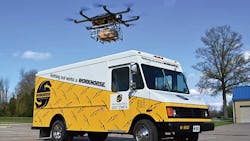WORKHORSE Group’s HorseFly line of Unmanned Aerial Vehicles (UAV) is designed to be the “last-mile” solution in delivery logistics, and the company is moving forward now that the Federal Aviation Administration (FAA) has granted an exemption to test the eight-rotor “octocopter” in tandem with its EPA-approved electric work trucks.
“Obtaining this authorization from the FAA is a vital step forward in making our HorseFly drone a practical component of our package delivery system by testing the drone’s unmanned flying capabilities,” said Stephen Burns, CEO of Workhorse Group. “We believe the pairing of the HorseFly drone and the Workhorse electric vehicle may usher in a significant improvement in reducing emissions and improving the efficiency of the delivery process.”
Burns said he has been asked if this is a “fantasy,” but he knows it’s going to happen because of the economics behind it: He said a diesel truck’s fuel and maintenance cost $1 per mile, but drones cost only two cents per mile on top of an electric truck’s 30 cents per mile.
The HorseFly UAV is given a package and a delivery destination by a delivery driver, using a touchscreen interface in the delivery truck.
The HorseFly launches itself from the delivery vehicle and ascends to a safe cruising altitude, then navigates to the desired delivery point autonomously using GPS navigation.
When the HorseFly reaches the GPS delivery destination, a human pilot in a remote location monitors the descent with a multi-camera video feed, and executes the package dropoff. The HorseFly then ascends back to a safe cruising altitude.
The HorseFly then navigates to the new location of the delivery truck, and uses Infrared (IR) Tracking to land and dock with the truck. The HorseFly then recharges its battery using the onboard battery of the electric vehicle.
It has a payload capacity of 10 pounds and an empty weight of 9.5 pounds, and can reach a maximum speed of 50 mph with a flight time of 30 minutes. It runs on Panasonic 18650 cells.
The FAA in November granted Workhorse Exemption No. 13564 (Regulatory Docket No. FAA-2015-3055) following the company’s petition requesting Section 333 exemption to test its HorseFly unmanned aerial system (UAS), stating that the “operation enabled by this exemption is in the public interest.”
The Section 333 Exemption process provides operators who wish to pursue safe and legal entry into the National Air Space a competitive advantage in the UAS marketplace, thus discouraging illegal operations and improving safety. It is anticipated that the use of UAS could result in significant economic benefits, and the FAA Administrator has identified this as a high priority project to address demand for civil operation of UAS for commercial purposes.
This exemption follows the receipt of a Certificate of Authorization to the Ohio/Indiana UAS Center and Test Complex, which allows Workhorse and the University of Cincinnati to continue their joint development of Workhorse Group’s HorseFly at the Wilmington Air Park in Wilmington, Ohio.
“We expect to keep our shareholders informed of progress as testing continues,” Burns said.
Workhorse Group is the parent company of AMP Electric Vehicles Inc and AMP Trucks Inc. AMP Electric Vehicles manufactures electric drive systems for medium-duty, Class 3-6 commercial truck platforms.
AMP Electric Vehicles was established in 2007 as a developmental-stage vehicle electrification company.
AMP Electric Vehicles went public in 2010 trading on the OTC market under the AMPD symbol. When the economic benefits of conversion became less certain, it pivoted away from passenger vehicles and began to focus on electrifying commercial vehicles. This led to a development agreement with Navistar. Under the development agreement, the initial project was to re-power a 1000-cubic foot delivery van. The first vehicle was delivered to them in August of 2012 and successfully passed Navistar’s requirements and performance test.
AMP acquired the Workhorse brand and the Workhorse Custom Chassis assembly plant in Union City, IN, in 2015. The asset acquisition made the company an OEM and enables the company to manufacture new, medium-duty truck chassis in the 14,500 to 23,500 GVW class.
In addition to the plant assets, there is an exclusive arrangement with UpTime Parts, Inc. for logistical and spare parts support, and a 400-plus network of dealers provides AMP with nationwide support for its vehicles.
In March 2015, AMP formally changed its name to Workhorse Group Incorporated (NASDAQ: WKHS).
About the Author
Rick Weber
Associate Editor
Rick Weber has been an associate editor for Trailer/Body Builders since February 2000. A national award-winning sportswriter, he covered the Miami Dolphins for the Fort Myers News-Press following service with publications in California and Australia. He is a graduate of Penn State University.
